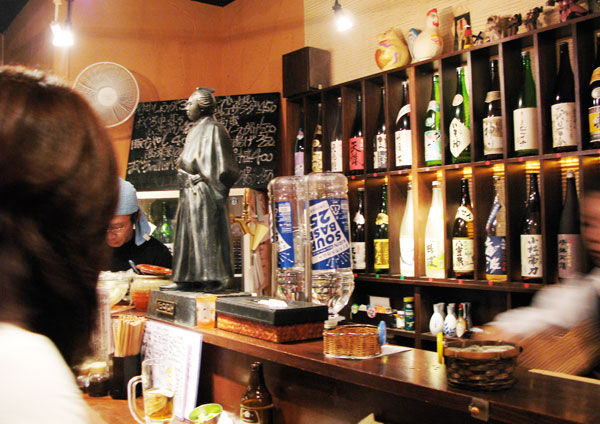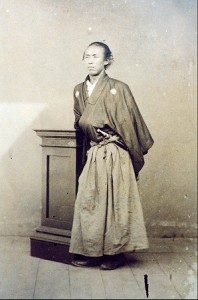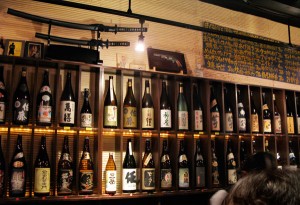 Well not exactly. Its a small statue of a sumurai on a bar counter that’s watching over you at a standing bar in Shimbashi, Tokyo. Posters and framed photo of this samurai are hanged all over the bar and even his katana or swords (fake, of course) are also displayed on the wall. I am quite certain that every Japanese could tell who this samurai is, he’s so famous here in Japan and a recent TV show were also a hit program.
Well not exactly. Its a small statue of a sumurai on a bar counter that’s watching over you at a standing bar in Shimbashi, Tokyo. Posters and framed photo of this samurai are hanged all over the bar and even his katana or swords (fake, of course) are also displayed on the wall. I am quite certain that every Japanese could tell who this samurai is, he’s so famous here in Japan and a recent TV show were also a hit program.
 He is Ryoma Sakamoto (1836 – 1867), a leader of the movement to overthrow the Tokugawa shogunate and a visionary who envisioned a new Japan, where Japanese people needed to modernize to compete with an industrially and technologically advanced outside world. He has also been seen as an intriguing mix of the traditional and modern, symbolized by his preference for samurai kimono while favoring western footwear. His death also coincide with the end of the Edo Period (1603 – 1867) and that’s also the end of samurais walking with katana swords on Japanese streets.
He is Ryoma Sakamoto (1836 – 1867), a leader of the movement to overthrow the Tokugawa shogunate and a visionary who envisioned a new Japan, where Japanese people needed to modernize to compete with an industrially and technologically advanced outside world. He has also been seen as an intriguing mix of the traditional and modern, symbolized by his preference for samurai kimono while favoring western footwear. His death also coincide with the end of the Edo Period (1603 – 1867) and that’s also the end of samurais walking with katana swords on Japanese streets.
Back at the bar, the bottles on the wall are all “shochu” and not “sake.” Shochu is a clear distilled liquors made either from sweet potatoes, barley, soba, or rice. The biggest difference between sake is that it’s distilled and not brewed. Most people will agree that with shochu, you don’t get hangovers and its more affordable compared to sake.
So the boom in Japan for shochu is still on and has surpassed the sake shipments few years ago. You could enjoy it either: straight, on the rocks, with water, with hot water, with soda, or with various fruit juices depending on the season or your preferred taste. Enjoy!







